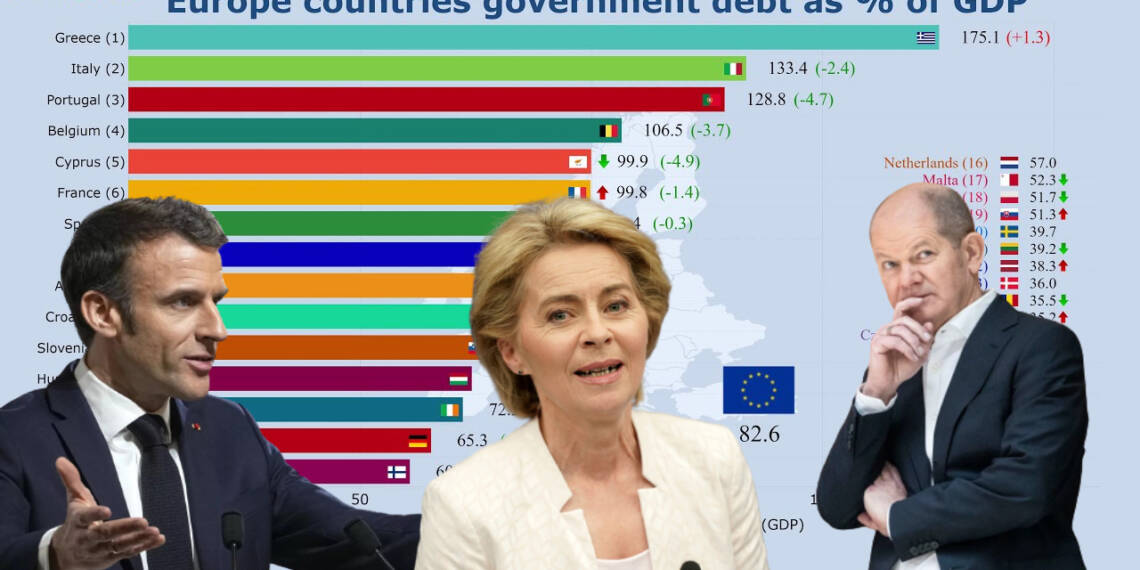In a world filled with economic uncertainties and political dramas, Europe’s financial landscape stands as a battleground of hidden truths and selective targeting. The Debt-to-GDP ratio, often hailed as the ultimate measure of fiscal stability, has taken center stage in this dramatic saga. But is it fair to single out Finland, while turning a blind eye to other European powerhouses grappling with similar challenges? Let’s peel back the layers and expose the hidden reality lurking beneath the surface.
The EU is saying that Finland is the only EU country above the debt barrier whose debt has continued to increase, according to an EU Commission report. Finland‘s public debt exceeded 73% of its GDP in 2017 and has consistently exceeded the 60% threshold required by EU legislation since 2013.
The Commission evaluates member state policies as part of its 2023 EU Spring Semester package with an eye towards the future.
The Commission concluded that Finland‘s debt reduction rules may have jeopardised the nation’s economic expansion.
The paper offers various suggestions on how Finland may address these issues, including implementing a responsible fiscal policy, addressing the labour shortage issue, and enhancing social security, among others.

You must be thinking that EU is so strict and Finland must be the only country which has debt to ratio exceeding that of 60% but wait, there’s more to it.
Enter Italy, the behemoth of European economies. With a jaw-dropping debt-to-GDP ratio of 155% in 2021, Italy’s economic woes should be ringing alarm bells. Adding fuel to the fire, a staggering 20.1% of the population found themselves trapped in the clutches of poverty in the same year. Yet, Italy has managed to dance through the EU’s scrutinizing gaze unscathed, leaving us pondering the motives behind such favoritism.
Portugal, too, bears the burden of a towering debt-to-GDP ratio, reaching a daunting 133% in 2021. Shockingly, 16.4% of the population found themselves teetering on the edge of poverty during the same period. How has Portugal managed to evade the punitive measures faced by others? The plot thickens.
Belgium, a seemingly idyllic nation, harbors a debt-to-GDP ratio of approximately 114%. But beneath its serene facade lies a staggering poverty rate of 13.2% as of December 2022. The juxtaposition between Belgium’s economic woes and its exemption from EU scrutiny raises eyebrows and demands answers.
Read More: Germany’s Threat of Sanctioning Hungary’s Biggest Private Bank Spells Doom for the EU
Cyprus, often overlooked in the European narrative, paints a picture of economic fragility with a debt-to-GDP ratio of 99% in 2021. The haunting reality is that 13.8% of its population is engulfed in the clutches of poverty, a statistic that cannot be brushed aside. Why does Cyprus continue to slip through the EU’s regulatory net?
Ah, France, the land of haute couture and cultural grandeur. Its debt-to-GDP ratio stands at a striking 115%. Yet, the French economy is deemed more sustainable compared to others. This favorable treatment is puzzling, especially when considering that 14.6% of the population endured the hardships of poverty in 2020. A double standard has clearly infiltrated the halls of the EU.
Meanwhile, Spain grapples with a debt-to-GDP ratio of approximately 119%. Its economy teeters on the edge of a precipice, yet Spain finds itself squarely in the EU’s firing line.
Read More: EU is an economically illiterate organization but Germany is economically the most illiterate
Germany, heralded as Europe’s economic powerhouse, boasts a seemingly modest debt-to-GDP ratio of 70% in 2021. However, recent recessional tremors expose the vulnerability lurking beneath its economic facade.
And last but not least, Austria, with a debt-to-GDP ratio of around 81%, also finds itself ensnared in the EU’s web of stringent measures.

The implications of this selective targeting reverberate throughout the European continent. It shatters the illusion of economic stability maintained by the so-called big guns of Europe. Germany, France, and Italy, despite their sky-high debt levels, manage to evade the EU’s scrutiny. It raises the question: is their prosperity nothing more than a mirage?
The truth lies in the shadows. The EU’s criteria for singling out countries extend far beyond the Debt-to-GDP ratio. Political and economic considerations weave an intricate web, obscuring the real motives behind their actions.
In the grand tapestry of European economics, Finland is just one thread, unfairly targeted while others remain unscathed. It is time for a reckoning, a comprehensive assessment that takes into account the multifaceted challenges faced by all member states.
Let us cast off the cloak of selective scrutiny and shed light on the true realities of Europe’s economic giants.
Hold your breath as the European drama unfolds, and the hidden truths break free from their shackles. The stage is set, and the spotlight is on. It’s time to rewrite the script, expose the secrets, and pave the way for a fair and just economic future.
https://www.youtube.com/watch?v=cvGYi4VDIRE







